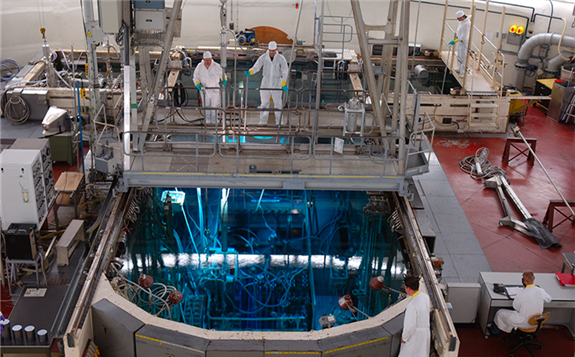As over two thirds of the world’s operating research reactors are now over 30 years old, operators and regulators are focusing on refurbishing and modernizing reactors to ensure they can continue to perform in a safe and efficient manner.

“The lifetime of research reactors is normally determined by the need for their use and their conformance with up-to-date safety requirements, since most of their systems and components can be replaced, refurbished or modernized without major difficulty,” said Amgad Shokr, Head of the IAEA’s Research Reactor Safety Section. “Refurbishment and modernization should not be limited to just systems and components; operators should also review safety procedures against IAEA safety standards to prevent the interruption of research reactor services.”
For more than 60 years, research reactors have been centres of innovation and development for nuclear science and technology programmes around the world. These small nuclear reactors primarily generate neutrons — rather than power — for research, education and training purposes, as well as for applications in areas such as industry, medicine and agriculture (learn more).
There are two kinds of ageing related to research reactors: physical ageing, which is the degradation of the physical condition of the reactor’s systems and components, and obsolescence, which is when the technology used for computers, instrumentation and control systems or safety regulations become outdated.
The ageing of facilities was one of the concerns that led to the IAEA initiating its Research Reactor Safety Enhancement Plan in 2001. This plan aims to help countries ensure a high level of research reactor safety. It includes the Code of Conduct on the Safety of Research Reactors, which provides guidance to countries on the development and harmonization of policies, laws and regulations regarding the safety of research reactors.
As part of this plan, countries work with the IAEA to implement systematic ageing management programmes that, among others, use good practices to minimize the performance degradation of systems and components, to continuously monitor and assess reactor performance and to implement practical safety upgrades. These ageing programmes can also benefit from operating programmes in other areas, such as maintenance, periodic testing, inspections and periodic safety reviews.
“While the number of operating research reactors is decreasing, the average age is increasing,” said Ram Sharma, a nuclear engineer on research reactor operation and maintenance at the IAEA. “So, it is of paramount importance to establish, implement and continuously improve plans for management, refurbishment and modernization to ensure cost-effective operation and utilization to get the most out of existing research reactors. IAEA support, such as peer review missions, can play a key part in achieving that goal.” Learn more about the IAEA’s research reactor-related peer review services.
Comprehensive support
Countries can draw on a range of IAEA support to address ageing at their research reactors. This includes assistance with developing safety standards and optimizing reactor availability, as well as adopting recommended practices based on IAEA-published collections on safety and using information disseminated by the IAEA on developing and implementing modernization and refurbishment projects. This assistance extends to new research reactor programmes and to assessing plans to proactively address ageing throughout all phases of the research reactor’s lifetime, from the design and selection of materials to the construction and operation of the facilities.
Review missions are initiated upon the request of a country and are supported by the IAEA and teams of international experts who carry out assessments and provide recommendations for further improvements. In November 2017, the first ageing management peer review mission for a research reactor was completed at Belgian Reactor 2 (BR2), which is one of three operating research reactors at the Belgian Nuclear Research Centre (SCK•CEN). The mission was based on the methodology of Safety Aspects of Long Term Operation (SALTO) missions for nuclear power plants and adapted to suit research reactors.
“The mission identified a number of items that were overlooked, such as ageing management of radioisotope production facilities and experimental devices,” said Frank Joppen, a nuclear safety engineer at SCK•CEN. “As a result, the classification systems of components are being updated, and feedback from maintenance, inspection and surveillance is being used to further improve ageing management programmes.”
In operation since 1963, BR2 is one of the oldest research reactors in Western Europe. It produces around one quarter of the global supply of radioisotopes for medical and industrial purposes, including for cancer therapy and medical imaging. It also produces a type of silicon that is used as a semiconductor material in electronic components. BR2 is now permitted to operate until its next periodic safety review in 2026, when a decision on extending its operation for another ten years may be taken.
“The ageing management programme of BR2 will be further developed, which means taking into account the remarks made during the IAEA mission,” Joppen said. “The efficiency of the programme will be reviewed and will be the subject of the next safety review.”
The next IAEA ageing management missions for research reactors have been requested by the Netherlands and Uzbekistan and are planned for 2020. “The BR2 mission showed that the SALTO methodology could be effectively applied to research reactors. We will continue to improve the efficiency and effectiveness of this mission, as well as other services, to maximize the benefits from research reactors,” Shokr said.
This article is reproduced at www.iaea.org